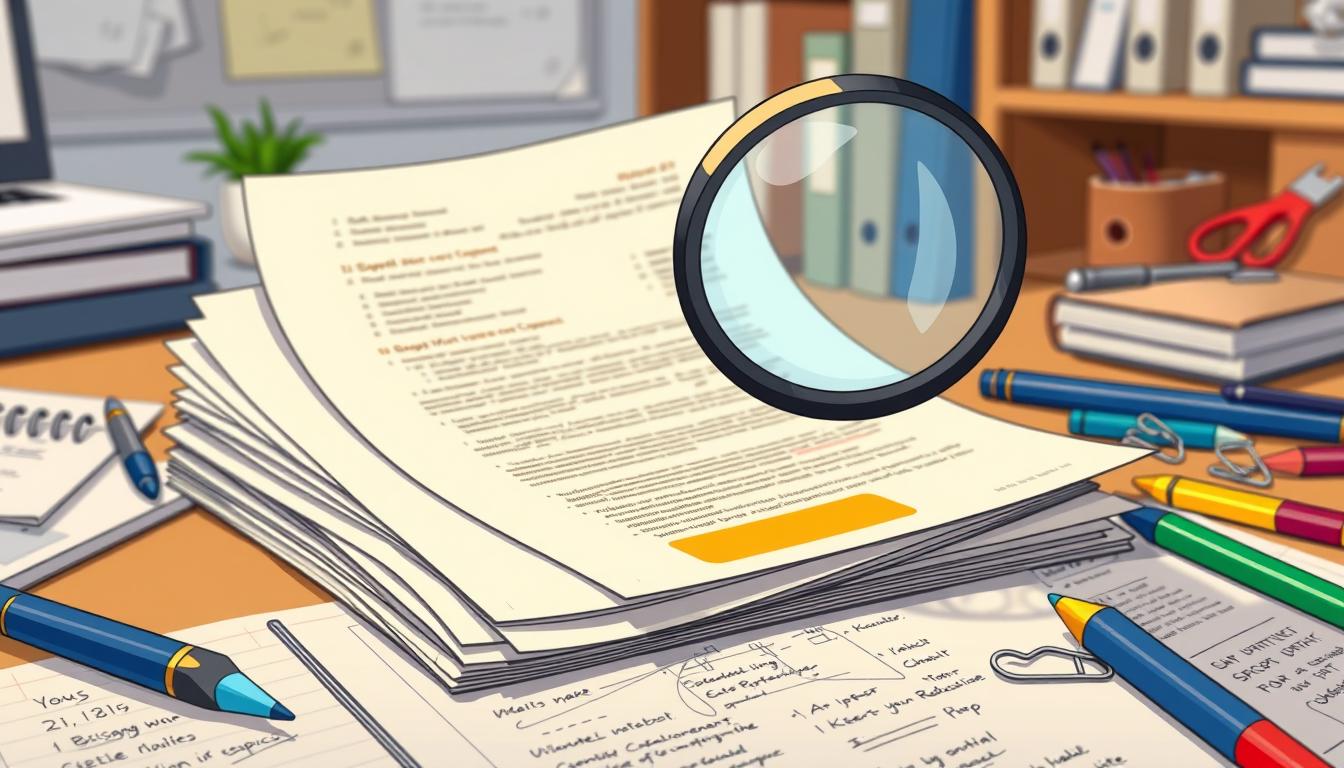Effective Techniques for Document Review
In today’s fast-paced business world, efficient document analysis and processing are key. Did you know that document review makes up 73% of litigation costs? Mastering effective document review techniques is vital for businesses in many fields, like sales, marketing, HR, and operations. But what are the essential steps to improve this critical process?
This guide will cover the important parts of a successful document review strategy. We’ll look at the basics, common challenges, and new solutions to change how you analyze documents. Whether you’re experienced or new to document review, this article will give you the tools to make your process better and help your business grow.
Understanding Document Review Fundamentals
Effective legal review strategies and contract review best practices are key to handling document review’s complexities. At the heart of this process is a deep grasp of the basic elements that shape the review workflow.
Core Components of Review Process
The document review process includes several key elements. These are content accuracy, formatting consistency, structural organization, language clarity, and compliance verification. It’s vital to address these elements well to ensure quality and reliability.
Types of Documents Requiring Review
Document review isn’t just for legal contracts. It also covers design specs, user manuals, engineering drawings, software code, and business-critical documents. Each document type has its own challenges and needs specialized knowledge to handle effectively.
Review Lifecycle Stages
The document review lifecycle has several stages. These are planning, initial review, feedback collection, revision, re-review, and final approval. Understanding and improving these stages helps organizations make their review workflows more efficient, accurate, and timely.
| Review Lifecycle Stages | Key Objectives |
|---|---|
| Planning | Set review goals, assign tasks, and set deadlines. |
| Initial Review | Examine documents for accuracy, formatting, and compliance. |
| Feedback Collection | Get feedback from relevant stakeholders. |
| Revision | Make changes based on feedback. |
| Re-review | Check if revisions meet standards. |
| Final Approval | Get final approval and release the documents. |
By grasping the core components, document types, and review lifecycle stages, organizations can craft a solid legal review strategy. They can also implement effective contract review best practices to improve their document review processes.
Key Challenges in Modern Document Review
The world of document review is changing fast. Legal teams face many complex challenges. With more data and less time to act, they must find new ways to work efficiently and accurately.
One big challenge is dealing with lots of electronic data. Most of the world’s data is unstructured and growing. Using both human skills and AI tools is key to finding important information quickly.
Legal teams also need specialized skills for big reviews. Skills like knowing foreign languages or technical knowledge can be expensive. Using new technology and expert help is vital to solve these problems and make document review more efficient.
| Challenge | Impact |
|---|---|
| Increasing data volumes | Over 80–90% of the world’s data is unstructured, and this percentage is projected to increase in the future. |
| Tight deadlines | The window for initial disclosures has narrowed from 120 to 90 days, putting significant time pressure on legal teams. |
| Need for specialized skills | Large-scale reviews often require additional capabilities, such as foreign language proficiency or technical expertise, driving up the cost of skilled workers. |
By using new technology, checking quality, and getting help from experts, legal teams can tackle these challenges. This way, they can make their document review work better, faster, and cheaper.
Effective Techniques for Document Review
In today’s world, reviewing documents is key for businesses. This is true for legal cases and internal checks. Companies use both old methods and new AI tools to make this process better and faster.
Manual Review Methods
Old-school document review relies on people checking documents. They look for errors, if the documents are relevant, and if they follow rules. This method uses the skills of experts, but it can take a lot of time and effort, especially with lots of documents.
Technology-Assisted Review (TAR)
Now, companies are using AI to help with document review. AI uses smart algorithms to sort documents, find important words, and spot oddities. This makes the review process faster and cheaper, thanks to AI’s speed and accuracy.
Hybrid Approach Benefits
The best way to review documents is to mix old methods with AI. This way, companies get the best of both worlds. They use human skills and AI’s power to review documents quickly and well.
A study in 2018 showed AI can review contracts better than lawyers. AI was 94% accurate and 26 seconds fast, while lawyers were 85% accurate and took 92 minutes. This shows AI can really help with document review, making it faster and more accurate.
“The hybrid approach to document review, combining human expertise with AI-powered tools, is the future of effective and efficient information management.”
Building a Strategic Review Framework
In the world of Document Analysis, having a strategic review framework is key. It keeps things efficient, consistent, and accountable. This includes making standard playbooks, clear rules, and detailed checklists.
By defining roles for team members and using a tagging system, reviews become smoother. Adding templates for feedback helps too. This makes the whole process easier and more effective.
To make reviews even better, use tools like Google Docs or Microsoft SharePoint. They help teams work together better and keep everyone updated. This way, everyone gets the latest info and can share their thoughts, making analysis better.
Frameworks for Strategic Planning
There are many ways to build a strong review framework. Here are some popular ones:
- SWOT Analysis Framework: Looks at Strengths, Weaknesses, Opportunities, and Threats to help make decisions.
- Problem-based Strategic Planning Framework: Focuses on solving current problems and making plans to fix them.
- Balanced Scorecard (BSC) Framework: Aligns goals and measures across different areas like finance and learning.
- Strategy Map Framework: Shows how objectives are connected and tracks progress.
- Objectives and Key Results (OKRs) Framework: Sets clear goals to motivate and hold teams accountable.
- Gap Planning Framework: Finds the gap between now and the desired future, then plans to close it.
Using these frameworks helps organizations create a flexible review process. It adapts to changes in the market and the company’s needs.
Regular strategic reviews are vital for staying ahead in Document Analysis. Companies should do dynamic reviews every quarter and health checks monthly. This ensures they can quickly adjust to changes and use resources wisely.
Leveraging Technology for Enhanced Review
In today’s fast-changing legal world, Text Analytics for Review and Leveraging Technology for Document Reviews are key. They help make the document review process smoother. With AI tools and advanced document systems, you can work faster, more accurately, and be more productive.
AI-Powered Review Tools
AI tools are changing how lawyers review documents. They can do tasks like sorting documents, finding important information, and understanding feelings in texts. This makes reviews quicker and more precise. Studies show lawyers using AI can save 20% to 90% of time on tasks.
Document Management Systems
Good document management systems are vital for efficient reviews. They help keep digital documents in one place, making them easy to find and share. Law firms using digital tools see better efficiency, happier clients, and more work done.
Analytics and Reporting Platforms
Analytics and reporting tools give insights into the review process. They help teams see what’s working and what needs improvement. By using this data, teams can make their reviews better and faster.
Using these technologies can greatly improve how lawyers review documents. It leads to better efficiency, accuracy, and productivity. As the legal field keeps growing, using Text Analytics for Review and Leveraging Technology for Document Reviews will be key to staying ahead and serving clients well.
Quality Control Measures in Document Review
Keeping quality high in document review is key for accurate and compliant results. A multi-layered quality assurance approach is vital. This ensures the final documents are reliable. Some important steps include:
- Standardized checklists and review protocols to verify accuracy, completeness, and adherence to guidelines
- Periodic audits of the review process to identify areas for improvement
- Self-review, peer review, and expert review to catch errors at different stages
- Automated grammar and spell-checking tools to detect basic mistakes
- Regular evaluation of review team performance and final document quality
With a strong quality control system, companies can make sure document processing is efficient. They can also deliver top-notch work that meets all standards.
Quality assurance (QA) is the last check before documents are approved. QA experts make sure all quality standards are met. They need to understand the document’s purpose well to ensure it’s accurate and complete.
They also check for missing pages, signatures, or needed information. It’s crucial to meet all acceptance criteria to follow company and regulatory rules. This helps avoid penalties and fines.
“Effective quality control measures are the cornerstone of a successful document review process, guaranteeing both efficiency and compliance.”
By using a strategic, multi-layered quality control method, companies can make their document processing smoother. They can lower errors and produce outstanding work that meets the highest standards.
Streamlining the Review Workflow
Improving the document review process is key for companies wanting to work better, save money, and maintain quality. By standardizing documents and using technology, a smart approach to Optimizing Review Processes can make a big difference.
Process Optimization Techniques
Standardizing documents and using templates are important steps in Optimizing Review Processes. This makes the review easier and keeps things consistent. Also, automating tasks like extracting metadata and sorting documents can really help speed things up.
Team Collaboration Strategies
Good teamwork is vital for smooth Optimizing Review Processes. Having clear communication, regular meetings, and using team platforms helps everyone work together better. It also helps solve problems quickly.
Timeline Management
Managing time well is key for Optimizing Review Processes. Setting realistic deadlines and using tools to track progress helps keep things on track. This ensures the review process is efficient and effective.
By using these strategies, companies can make their document review process better. This leads to more productivity and a more efficient review process.
| Optimization Technique | Key Benefits |
|---|---|
| Standardized Document Formats | Simplified review process, consistent formatting |
| Automated Repetitive Tasks | Increased productivity, reduced manual effort |
| Effective Team Collaboration | Improved communication, faster issue resolution |
| Comprehensive Timeline Management | Adherence to deadlines, identification of bottlenecks |
“Streamlining the document review process is a strategic imperative for organizations seeking to enhance efficiency, reduce costs, and ensure quality.” – Industry Expert
Compliance and Security Considerations
Legal review strategies must focus on compliance and security. Documents must follow all relevant laws and standards. This ensures the integrity of organizations and avoids legal issues.
Security is key, including protecting confidential info and keeping attorney-client privilege. Proper redaction techniques are also vital during the review process.
Keeping data private and handling sensitive documents with care is crucial. Organizations need strong protocols to protect information. This includes access controls, encryption, and data backup and recovery plans.
| Compliance Considerations | Security Measures |
|---|---|
|
|
By focusing on compliance and security, organizations can make their Legal Review Strategies strong. This protects their reputation and legal standing. It also builds trust with clients and stakeholders.
“Effective compliance documentation supports accountability, governance, and legal adherence within an organization.”
As laws change, it’s important to stay updated. Regularly reviewing and updating compliance protocols is key. This helps organizations stay ahead of Legal Review Strategies.
Best Practices for Review Team Management
Creating a skilled and coordinated team is key for effective document review. It’s important to set up the right team structure and roles. Also, training and performance metrics are crucial for quality and improvement.
Team Structure and Roles
Building a balanced team is essential. Include experts in law, subject matter, and technology. This mix ensures a detailed and quick review. Make sure each team member knows their role to work better together.
Training and Development
Training is vital for the team. Teach them about the review process, industry knowledge, and tool use. Regular training keeps them skilled and ready for new challenges.
Performance Metrics
Using strong performance metrics is key. Track accuracy, speed, and consistency. Feedback and improvement help the team grow. This ensures top-quality results.
Focus on team structure, training, and performance to create a strong document review team. This way, you can deliver Effective Techniques for Document Review.
“Substantive daily reports are highly beneficial for document reviews, as demonstrated by the automation of reporting functions providing enhanced benefits in terms of efficiency and accuracy.”
Conclusion
Effective document review uses both human skills and advanced tech for better results. It combines strategic plans, AI tools, and strict quality checks. This way, companies can make their document review processes more accurate, efficient, and compliant.
It’s important to keep improving these methods as challenges change. This ensures they stay effective in today’s document review world.
Having a team with both legal and tech skills is crucial for a good document review. Using set rules, templates, and automation can make things smoother. It also saves time.
Adding data analytics and reporting tools gives valuable insights. These tools help improve the review process and find areas for betterment.
In the end, a mix of human insight and technology is the best way to handle document review. This approach works well in today’s complex legal and data world.
By being alert, flexible, and focused on quality, companies can meet their goals. They can ensure their document review is accurate, efficient, and compliant. This leads to better results for their clients and stakeholders.
Source Links
- Document Review Process: Tips & Best Practices for 2024
- The Documentation Review Process: A Practical Guide
- 6 Simple Steps To Accelerate Your Legal Document Review Process
- Document Analysis – What, Why and How
- Document Review Challenges: Strategies for Law Firm Litigation Professionals in 2024 – Integreon
- 9 Keys to Successful Document Review in Discovery
- Legal Document Review Hurdles: Veritone Solutions
- Documentation Review Process: Guide, Tips & Tricks for Success [2024]
- 5 Essential Best Practices for an Effective Document Review Process
- Document Review – Basics of eDiscovery | Logikcull
- 8 Strategic Planning Frameworks to Achieve Your Goals
- Strategy Review: How To Run It & What To Include
- How to Conduct a Strategy Review: Steps and Benefits
- Leveraging Technology for Efficient Legal Research and Documentation
- How to optimize the document review process
- Leveraging Technology For Efficient Document Management And E-Discovery Processes | Legal Bill Review
- A Simple and Helpful Guide to Quality Document Review
- Deconstructing Document Review: A Guide for Reviewers – First Legal
- Streamlining Your Legal Document Review: Top Tips for Efficiency
- 8 Tips for Successful Technical Document Review Process – Cflow
- Mastering Document Review Best Practices for Efficient and Accurate Results
- Mastering the Documentation Review Process: A Complete Guide
- Documentation Review Process: Tips & Best Practices for 2024
- The Art Of Documentation: Unraveling Best Practices For Compliance | Learnexus
- Document Review Management Best Practices: Daily Reports
- Best Practices for Managing More Efficient and Accurate Document Reviews | News & Publications
- Document Review: 6 Tips For A More Efficient Process | JD Supra
- A Simple and Helpful Guide to Quality Document Review
- Tips to Streamline Legal Document Review Process







